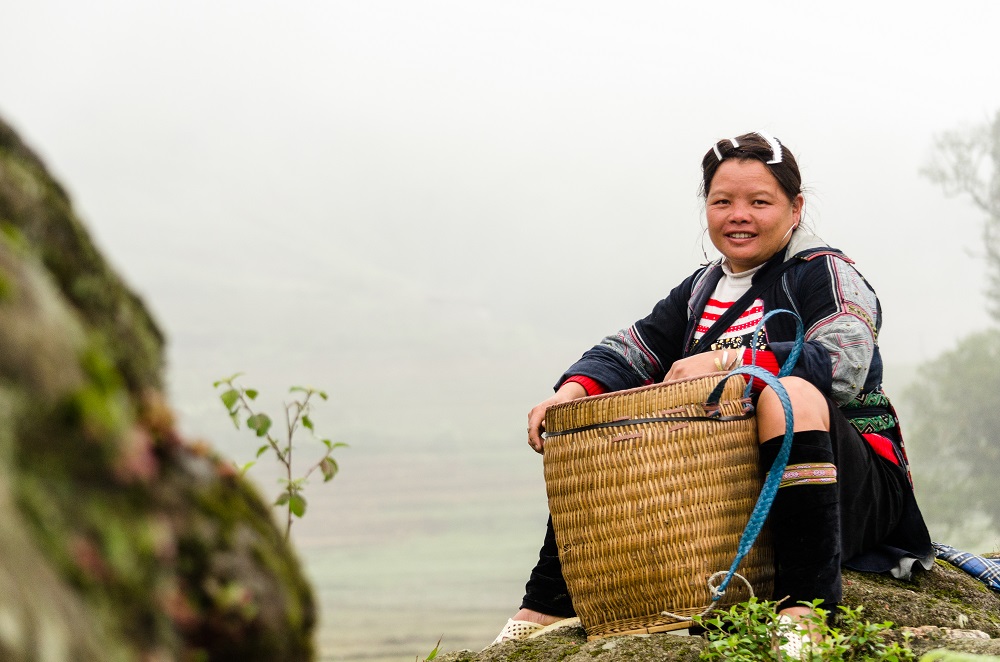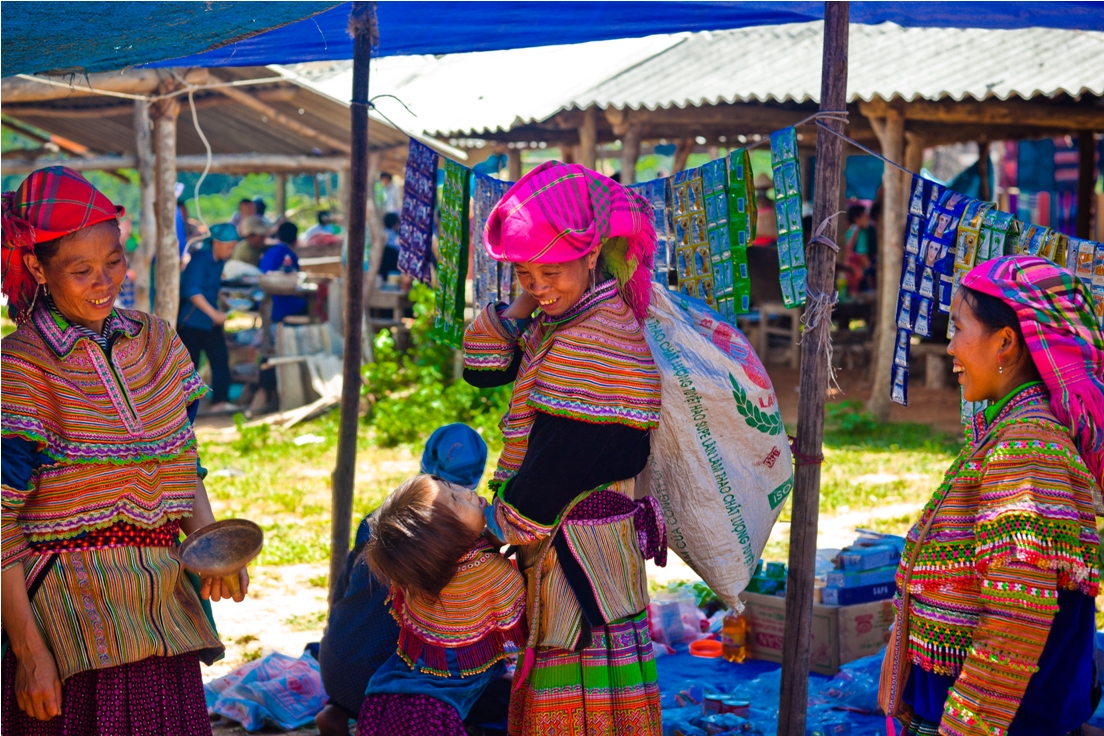Traditional Hmong Textiles-Buying Guide
Hmong people are easily spotted by their colourful handmade outfits, from embroidered hats to handwoven baby carriers. As the Hmong don’t traditionally have a written language, textiles have become a form of visual expression. Fabric motifs are often inspired by nature, such as snail shells, animal teeth, ferns, seeds and even cucumbers!
The Hmong people are recognisable from their bright, detailed dress, much of which is readily available to buy as souvenirs. We share seven simple steps to buying traditional Hmong clothes and textiles that benefits both you and the Hmong community.
The Hmong are an ethnic group that are thought to originate from the plains of Tibet and Mongolia, moving southwards through China. Nowadays, they are known to live in the mountainous parts of China, Vietnam, Laos and Thailand.
If you’re visiting Sapa in Vietnam or Luang Prabang in Laos, you’re likely to meet groups of persuasive Hmong women selling their wears with vigor. It’s easy to be overwhelmed with so many options of souvenirs in every possible colour, but these unique items are well worth the effort. Curious how to get started? Check our these simple steps to buying Hmong textiles, plus tips on how to get the best and most authentic textile keepsakes.
Step 1: Find your seller

In most cases, you won’t have to search out Hmong sellers, they will come to you! However, it is a good idea to be aware of who exactly you are buying from. There are a variety of subgroups of Hmong people across Southeast Asia, from the ‘Flower Hmong’ in Vietnam to the ‘Hmong Du’ in Laos.
Most Hmong subgroups will speak entirely different languages, from both their home country and each other, and offer completely different styles of textiles. There are a vast array of cultures and backgrounds which add to the uniqueness of your souvenirs. Don’t miss the opportunity to learn who you are buying from while you have the chance!
Also, choose carefully where you buy from. If you can’t buy from the Hmong people directly, visit reputable companies and social enterprises, such as Ock Pop Tok. Places that have a mission of working closely with artisan producers are a good source of fair trade Hmong textiles.
Fact: In Laos alone, there are three subgroups of Hmong; the Hmong Dao (White), Hmong Du (Blue) and Hmong Djua (Striped). There are more subgroups of Hmong across Southeast Asia, and the group that you visit will determine the pattern and style of textiles you are offered.
Step 2: Know your fabrics
Hmong textiles are made from a variety of raw materials, such as cotton, hemp, banana fibre, mulberry fibre and silk. Each of the materials have slightly different qualities, from soft and flexible cotton to satin-like banana fibre, though all tend to be natural, comfortable and durable. The best way to find out more about Hmong fabrics is simply to ask the seller lots of questions.

Perhaps more important than choosing which fabric you want is appreciating the time and effort that goes into making them. Each material requires a slightly different processes to create, but most require collecting the raw material before spinning, dying, weaving and sewing.
For example, making hemp fibre for the Hmong loom is an extremely long process. The hemp plant grows for about 2 ½ months before it is harvested. The leaves are then stripped away and the stalks are dried for 15 days before being peeled. Next the peeled stalks are twisted together and pounded to make them softer. Finally, the fibres are spun into skeins of thread, washed in ash water and wound into a ball. The arduous process can take over 3 months before any weaving actually begins!
Fact: A traditional Hmong skirt can take up to 4 – 6 months to make. This includes harvesting from the fields, spinning, weaving, designing the pattern, wax printing, dying, embroidery and applique.
Step 3: Understand the patterns
Traditionally, Hmong people only made textiles for personal use. Clothes were made for both everyday use and special occasions, such as weddings, funerals and the new year. Since the Hmong didn’t have a traditionally written language, the motifs and patterns on these textiles were often used as a form of expression. Especially before each new lunar year, Hmong women would design garments with meaningful symbols that they would like to be part of their life in the coming year. This tradition is still followed today and women’s hopes for the future can often be seen worn on the cuffs of their sleeves.
Fact: The ‘fish hook’ symbol is often used by young women who would like to attract a husband. Whereas, the ‘chicken foot’ symbol is used by elderly people in relation to the spirit world.
Step 4: Pick your item

Hmong textiles are not just for souvenirs, but very much a part of everyday life for the Hmong. As a result, there are few items of clothing that cannot be found for sale. Trousers, shirts, jackets, head scarves, hats, bags and belts can all be found hanging up at markets.
In more recent years, some of the Hmong people adapted their embroidery to Western audiences. Clothing of more muted colours, tapestries and ‘story cloths’ filled with war stories can also be found. Some traditional clothing pieces have also been adapted to the taste of tourists. For example, square waist bands worn by Hmong women are often turned into pillow cases, table cloths and wall hangers.
In short, there is truly no end of choice! Look around and find things that you will wear or keep in your house. There’s both traditional, colourful items and contemporary, low-key goods.
Tip: Don’t say ‘maybe’ if the answer is ‘no’. Many tourists think it’s impolite to simply say no but, in actual fact, many Hmong sellers would rather just be given an honest answer. They are often on their feet, tirelessly selling all day, and would much rather not waste their time on those who are not interested.
Step 5: Settle on a price
Find a price that works for both you and your seller. Contrary to what many people think, heavily bargaining is not appreciated. Some items may be more expensive than you originally expect but keep in mind that some of the products will have taken months to create.
Handwoven products are much more expensive than machine-woven products but they are often higher quality and much more authentic. Each handmade piece has a story and a skilled producer behind it — making it truly one-of-a-kind. The technique has been handed down through generations. However, with each generation, there are less willing to take the time to learn it properly. By purchasing products that are made following these traditions, you’re not only providing immediate incomes to families now, but also reinforcing to future generations that this is a valuable source of income and worthwhile skill to learn.
Although handwoven products cost more, buying them promotes the continuation of traditional Hmong textiles. Voting with your dollar will ensure Hmong people can continue to make a living from skills passed down through generations.
Tip: An easy way to tell if your item is handwoven is to look at the back of the material. If there is any visible hand-stitching or slight imperfections, it is more likely to be handwoven.
Step 6: Learn more
There’s much more time and effort that goes into Hmong textiles than meets the eye. Arguably, the history and process behind these textiles are just as beautiful as the items themselves. One of the best ways to learn about the intriguing processes behind Hmong textiles is to take a workshop. There’s all sorts of opportunities to get hands on, from batik classes in Vietnam to a dying workshops in Laos.
Ock Pop Tok also offers free tours of their weaving centre to teach more about fabrics — and the culture and history behind them. Or, visitors can visit the Fibre2Fabric nonprofit gallery that exhibits heritage collections in an effort to preserve them. There are many other organizations that allow you to learn more about aspects of the country’s culture, including the Traditional Arts and Ethnology Centre, which focuses on Lao ethnic groups.
Fact: One of the most distinguishable Hmong textiles is batik, a resist dye technique with white motifs created with bees wax. Bamboo pens with metal nibs are used to draw the wax onto hemp, then the wax marks will resist being dyed when the cloth is dipped in the indigo pot. To achieve the dark shades of blue seen on batik designs, the cloth may be dyed more than 20 times over a period of two weeks.
Step 7: Keep the tradition going

Whether it’s wearing your goods with pride or sharing pictures of Hmong textiles with friends, word of mouth can go a long way. Sharing your story with people at home is a great way to spread demand for high quality, authentic Hmong textiles. Another way to support the creation of Hmong textiles is to donate to a Hmong village or sign up to a textiles workshop




